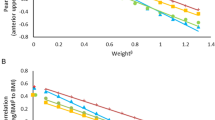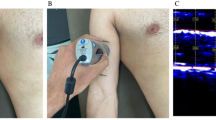Abstract
Background/Objectives
Ultrasound is used to measure muscle and adipose tissue thickness at the bedside. This study was aimed at determining the intra- and inter-examiner reliability for marking points to measure adipose tissue and muscle thickness and assessing it in terms of the performance and evaluation of the corresponding ultrasound scans.
Subjects/Methods
Intra- and inter-examiner reliability was tested in 120 patients. Limb lengths were measured to mark three and two measuring points on both the thighs and upper arms, respectively. Ultrasound scans were performed at each measuring point to evaluate muscle and adipose tissue thickness.
Results
Regarding the marking of the measuring points, intra- and inter-examiner reliability were high to very high, with correlation coefficients ranging from 0.74 to 0.96. In the performance and evaluation of adipose tissue thickness, all measuring points showed a high to very high reliability, with correlation coefficients ranging from 0.70 to 0.97. In the performance and evaluation of muscle thickness, the ventral measuring point on the thigh and the anterior measuring point on the upper arm showed the best reliability, with high to very high correlation coefficients ranging from 0.77 to 0.93.
Conclusions
In terms of intra- and inter-examiner reliability, the ventral measuring point on the thigh and the anterior measuring point on the upper arm can be strongly recommended for ultrasound measurements of muscle and adipose tissue thickness.
This is a preview of subscription content, access via your institution
Access options
Subscribe to this journal
Receive 12 print issues and online access
$259.00 per year
only $21.58 per issue
Buy this article
- Purchase on SpringerLink
- Instant access to full article PDF
Prices may be subject to local taxes which are calculated during checkout


Similar content being viewed by others
References
Weijs PJM, Looijaard WGPM, Dekker IM, Stapel SN, Girbes AR, Oudemans-van Straaten HM. et al. Low skeletal muscle area is a risk factor for mortality in mechanically ventilated critically ill patients. Crit Care. 2014;18:R12.
Fülster S, Tacke M, Sandek A, Ebner N, Tschöpe C, Doehner W, et al. Muscle wasting in patients with chronic heart failure: results from the studies investigating co-morbidities aggravating heart failure (SICA-HF). Eur Heart J. 2013;34:512–9.
Prado CM, Lieffers JR, McCargar LJ, Reiman T, Sawyer MB, Martin L, et al. Prevalence and clinical implications of sarcopenic obesity in patients with solid tumours of the respiratory and gastrointestinal tracts: a population-based study. Lancet Oncol. 2008;9:629–35.
Martin L, Hopkins J, Malietzis G, Jenkins JT, Sawyer MB, Brisebois R, et al. Assessment of computed tomography (ct)-defined muscle and adipose tissue features in relation to short-term outcomes after elective surgery for colorectal cancer: a multicenter approach. Ann Surgical Oncol. 2018;25:2669–80.
Wischmeyer PE, Puthucheary Z, San Millán I, Butz D, Grocott MPW. Muscle mass and physical recovery in ICU: innovations for targeting of nutrition and exercise. Curr Opin Crit Care. 2017;23:269–78.
Cederholm T, Jensen GL, Correia MITD, Gonzalez MC, Fukushima R, Higashiguchi T, et al. GLIM criteria for the diagnosis of malnutrition––A consensus report from the global clinical nutrition community. Clin Nutr. 2019;38:1–9.
Shen W, Punyanitya M, Wang Z, Gallagher D, St-Onge M-P, Albu J, et al. Total body skeletal muscle and adipose tissue volumes: estimation from a single abdominal cross-sectional image. J Appl Physiol. 2004;97:2333–8.
Mourtzakis M, Prado CMM, Lieffers JR, Reiman T, McCargar LJ, Baracos VE. A practical and precise approach to quantification of body composition in cancer patients using computed tomography images acquired during routine care. Appl Physiol, Nutr, Metab. 2008;33:997–1006.
Prado CMM, Heymsfield SB. Lean tissue imaging: a new era for nutritional assessment and intervention. J Parenter Enter Nutr. 2014;38:940–53.
Gibby JT, Njeru DK, Cvetko ST, Heiny EL, Creer AR, Gibby WA. Whole-body computed tomography-based body mass and body fat quantification: a comparison to hydrostatic weighing and air displacement plethysmography. J Computer Assist Tomogr. 2017;41:302–8.
Fischer A, Anwar M, Hertwig A, Hahn R, Pesta M, Timmermann I, et al. Ultrasound method of the USVALID study to measure subcutaneous adipose tissue and muscle thickness on the thigh and upper arm: an illustrated step-by-step guide. Clin Nutr Exp. 2020;32:38–73.
Saito R, Ohkawa S, Ichinose S, Nishikino M, Ikegaya N, Kumagai H. Validity of mid-arm muscular area measured by anthropometry in nonobese patients with increased muscle atrophy and variation of subcutaneous fat thickness. Eur J Clin Nutr. 2010;64:899–904.
Müller W, Horn M, Furhapter-Rieger A, Kainz P, Kropfl JM, Maughan RJ, et al. Body composition in sport: a comparison of a novel ultrasound imaging technique to measure subcutaneous fat tissue compared with skinfold measurement. Br J Sports Med. 2013;47:1028–35.
Fischer A, Spiegl M, Altmann K, Winkler A, Salamon A, Themessl-Huber M, et al. Muscle mass, strength and functional outcomes in critically ill patients after cardiothoracic surgery: does neuromuscular electrical stimulation help? The Catastim 2 randomized controlled trial. Crit Care. 2016;20:30.
English CK, Thoirs KA, Fisher L, McLennan H, Bernhardt J. Ultrasound is a reliable measure of muscle thickness in acute stroke patients, for some, but not all anatomical sites: a study of the intra-rater reliability of muscle thickness measures in acute stroke patients. Ultrasound Med Biol. 2012;38:368–76.
Müller W, Lohman TG, Stewart AD, Maughan RJ, Meyer NL, Sardinha LB, et al. Subcutaneous fat patterning in athletes: selection of appropriate sites and standardisation of a novel ultrasound measurement technique: ad hoc working group on body composition, health and performance, under the auspices of the IOC Medical Commission. Br J Sports Med. 2016;50:45–54.
Perin F, Pittet J-C, Schnebert S, Perrier P, Tranquart F, Beau P. Ultrasonic assessment of variations in thickness of subcutaneous fat during the normal menstrual cycle. Eur J Ultrasound. 2000;11:7–14.
Sions JM, Velasco TO, Teyhen DS, Hicks GE. Ultrasound imaging: intraexaminer and interexaminer reliability for multifidus muscle thickness assessment in adults aged 60 to 85 years versus younger adults. J Orthop Sports Phys Ther. 2014;44:425–34.
Paris MT, Lafleur B, Dubin JA, Mourtzakis M. Development of a bedside viable ultrasound protocol to quantify appendicular lean tissue mass. J Cachexia, Sarcopenia Muscle. 2017;8:713–26.
Strasser EM, Draskovits T, Praschak M, Quittan M, Graf A. Association between ultrasound measurements of muscle thickness, pennation angle, echogenicity and skeletal muscle strength in the elderly. Age. 2013;35:2377–88.
Mechelli F, Arendt-Nielsen L, Stokes M, Agyapong-Badu S. Inter-rater and intra-rater reliability of ultrasound imaging for measuring quadriceps muscle and non-contractile tissue thickness of the anterior thigh. Biomed Phys Eng Express. 2019;5:037002.
Müller W, Fürhapter-Rieger A, Ahammer H, Lohman TG, Meyer NL, Sardinha LB, et al. Relative body weight and standardised brightness-mode ultrasound measurement of subcutaneous fat in athletes: an international multicentre reliability study, under the auspices of the ioc medical commission. Sports Med. 2020;50:597–614.
Fivez T, Hendrickx A, Van Herpe T, Vlasselaers D, Desmet L, Van den Berghe G, et al. An analysis of reliability and accuracy of muscle thickness ultrasonography in critically ill children and adults. J Parenter Enter Nutr. 2016;40:944–9.
Von Elm E, Altman DG, Egger M, Pocock SJ, Gøtzsche PC, Vandenbroucke JP. The strengthening the reporting of observational studies in epidemiology (STROBE) statement: guidelines for reporting observational studies. PLOS Med. 2007;4:1623–7.
Grimm A, Teschner U, Porzelius C, Ludewig K, Zielske J, Witte OW, et al. Muscle ultrasound for early assessment of critical illness neuromyopathy in severe sepsis. Crit Care. 2013;17:R227.
Cartwright MS, Kwayisi G, Griffin LP, Sarwal A, Walker FO, Harris JM, et al. Quantitative neuromuscular ultrasound in the intensive care unit. Muscle Nerve. 2013;47:255–9.
Hill JC, Millán IS. Validation of musculoskeletal ultrasound to assess and quantify muscle glycogen content. A novel approach. Physician Sportsmed. 2014;42:45–52.
English C, Fisher L, Thoirs K. Reliability of real-time ultrasound for measuring skeletal muscle size in human limbs in vivo: a systematic review. Clin Rehabilitation. 2012;26:934–44.
Nijholt W, Scafoglieri A, Jager-Wittenaar H, Hobbelen JSM, van der Schans CP. The reliability and validity of ultrasound to quantify muscles in older adults: a systematic review. Journal of Cachexia. Sarcopenia Muscle. 2017;8:702–12.
Perin F, Perrier C, Pittet JC, Beau P, Schnebert S, Perrier P. Assessment of skin improvement treatment efficacy using the photograding of mechanically-accentuated macrorelief of thigh skin. Int J Cosmet Sci. 2000;22:147–56.
Störchle P, Müller W, Sengeis M, Ahammer H, Fürhapter-Rieger A, Bachl N, et al. Standardized ultrasound measurement of subcutaneous fat patterning: high reliability and accuracy in groups ranging from lean to obese. Ultrasound Med Biol. 2017;43:427–38.
Müller W, Horn M, Fürhapter-Rieger A, Kainz P, Kröpfl JM, Ackland TR, et al. Body composition in sport: Interobserver reliability of a novel ultrasound measure of subcutaneous fat tissue. Br J Sports Med. 2013;47:1036–43.
Acknowledgements
We thank all the staff members of the departments of the USVALID Collaboration Group for welcoming our research team to recruit the patients. The representative members of the USVALID Collaboration Group are listed in the Supplementary Information. We thank all the patients who participated in the USVALID study. We thank our friends, listed in the Supplementary Information, who volunteered as healthy individuals during the training phase prior to the trial. The manuscript was edited by a scientific English editing service.
Author information
Authors and Affiliations
Contributions
AF contributed to the conception, design, patient recruitment, data collection, data analysis and writing. RH, AH, MA, MP, IT, TS, and KL contributed to patient recruitment and data collection. JB and IS contributed to data analysis. MP contributed to conception and data analysis. MH contributed to conception, design, supervision, and writing. All authors contributed to reviewing. All authors read and approved the final manuscript.
Corresponding author
Ethics declarations
Conflict of interest
The authors declare no competing interests.
Additional information
Publisher’s note Springer Nature remains neutral with regard to jurisdictional claims in published maps and institutional affiliations.
Supplementary information
Rights and permissions
About this article
Cite this article
Fischer, A., Hahn, R., Anwar, M. et al. How reliably can ultrasound help determine muscle and adipose tissue thickness in clinical settings? An assessment of intra- and inter-examiner reliability in the USVALID study. Eur J Clin Nutr 76, 401–409 (2022). https://doi.org/10.1038/s41430-021-00955-w
Received:
Revised:
Accepted:
Published:
Issue date:
DOI: https://doi.org/10.1038/s41430-021-00955-w



